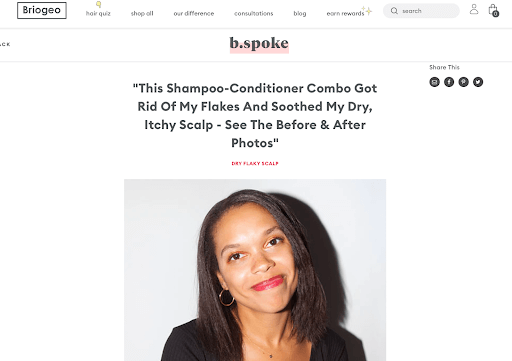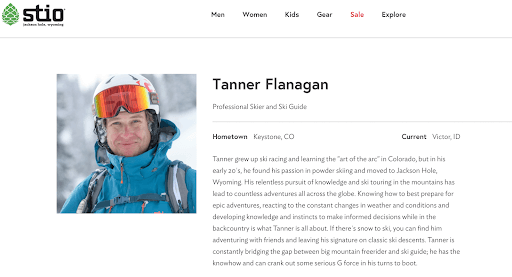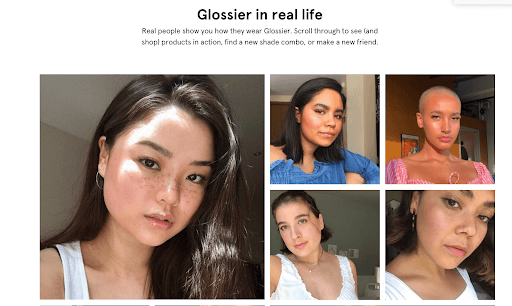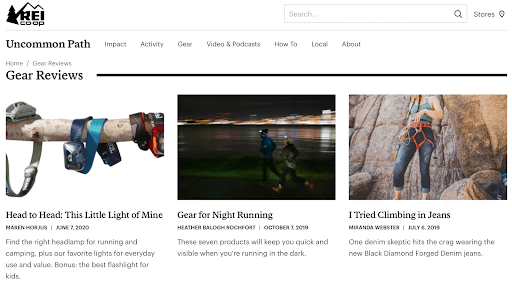Testimonial Page Examples: 7 Ways to Highlight Customer Testimonials
When potential customers find you online, they can only get to know you through what you share online – specifically, your website. It can be hard to build trust this way: how can you come off as a trustworthy company in a digital space? To prove your value and credibility, why not let your customers do the talking?
When potential customers find you online, they can only get to know you through what you share online – specifically, your website. It can be hard to build trust this way: how can you come off as a trustworthy company in a digital space?
To prove your value and credibility, why not let your customers do the talking? This is where testimonials come in. Testimonials are honest endorsements of your product or service.
When done well, a testimonial has the power to influence others beyond anything your website can say.
Read on to learn more about the power of testimonials and to see testimonial page examples before learning how to replicate these strategies for your testimonial page.
Types of Testimonials
Testimonials come in various shapes, sizes, and formats. But before we dig into how to highlight the great testimonials you can receive, here’s an overview of the different types of testimonials that you can leverage:
- Quote testimonials: these are short written words of praise that customers share. Either they might share their testimonial directly with you, or they give a review online.
- Social media testimonials: these testimonials are shared on social – either intentionally or in a conversation with others. You can showcase these through sharing, commenting, or liking social media content that contains a testimonial.
- Influencer testimonials: These are given by paid influencers or celebrities. Influencer testimonials because the people giving them have a direct influence on your target audience as a voice they can trust.
- Review posts: These are product reviews published by affiliates on other sites. You might find it helpful to share these if the review shows your benefits over the competitor(s).
- Case studies: These are testimonials that you create in collaboration with customers. The aim is to capture the before and after of the customer using the product with an emphasis on the results your business helped the client achieve.

Ways to Highlight a Customer Testimonial
Regardless of how the testimonial comes in, there are various strategies that you can use to highlight aspects of the testimonial in ways that will resonate with your audience. You can even take one testimonial and use it several different ways – like in social media and blog posts, for example.
Below are examples of some of the more creative testimonial pages we’ve seen, or just great examples of a testimonial done well. We also include some tips on how to best make each type work for your website.
1. Show Authenticity
Although testimonials are easy to fake, your readers will likely know when an opinion is genuine or not. An authentic testimonial will show how the customer’s problem and how your product/service improved the customer’s life. When potential customers read testimonials, they’re stepping into the person’s shoes and see themselves using your product.
Briogeo’s Blog

This haircare brand’s blog features transformation stories from customers. These blogs work because of the customer’s reservations at first. For example, in this post, user Jeanine doesn’t hesitate to share that she doubted if Briogeo’s products would deliver results.
How to replicate this:
- Seek honest reviews of your product or service. You can even give your product or service away for free in exchange for honest reviews. Or, you can encourage regular folks to give an honest review in exchange for some sort of compensation (such as a gift card, discount, coupon, or additional perk.)
- Ask customers to tell you whether they doubted your company and how you exceeded their expectations. Other prospects might have similar reservations about doing business with you, but a testimonial like the one above will reduce those reservations.
- Resist the urge to cut out anything in the testimonial that may give a negative depiction of your company. The point here is to show how customers may have misjudged you or your product and how they feel now. Authenticity is about showing the good, the bad, and the ugly. Customers are looking for an authentic reaction, and not a cherry-picked, overly-positive review.
2. Keep it Short
People are busy, and long testimonials look daunting to read. Therefore, keep your testimonials to a few paragraphs – or even shorter. When a customer testimonial is short and direct and includes action-centric words that capture emotions, it motivates visitors to keep reading.
Fabletics’ #MyFabletics Hashtag

Fabletics encourages customers to post themselves on their Instagram pages wearing Fabletics products and tagging “#MyFabletics.” This is one of the most cost-effective methods for collecting unbiased customer testimonials, and it’s also super short and to the point. The sheer volume of posts tagged with #MyFabletics does all of the talking here.
How to Replicate this:
- You can create a hashtag and easily start promoting it on your Instagram account without needing to pay a single dime. Even if users don’t write a lengthy caption singing praises to your product, a picture will more than say enough. The quality of the product and the user’s emotion in the picture will show that your product in an authentic way.
- Make sure to share or highlight those who use your hashtag to show customers that you recognize this small effort and to encourage more users to tag their posts.
3. Be Specific
A specific testimonial avoids the use of cliches like “this product was great,” and similar phrases that don’t really mean anything. Great testimonials talk about specific benefits that you provide, beyond anything in your marketing materials. Make sure the testimonials you feature dig deeper than “I love [brand name]!”
Zendesk’s Case Studies

Zendesk has a dedicated customer page that contains specific success stories. In this example, there are testimonials from customers at Tile who offer their story as social proof to readers. The testimonial also specifically highlights the challenges the company faced and how Zendesk helped.
How to replicate this:
- Using statistics is an excellent way to add specificity. If it isn’t possible to use statistics, detailing the problem and sharing a story of how the product specifically helped solve the problem is another way to create a specific testimonial.
- Choose reviews from customers who can highlight specific use cases for your product or service so readers can envision their own specific use cases that your brand could help with.
- Ideally, your customers will agree to serve as case studies, and you’ll be able to publish stories with specific details that they can share about how your product or service helped them.
4. Personalize
Personalizing the testimonial makes it easier for readers to be empathetic and to see themselves using the product or service in their everyday lives. It also helps potential customers remember the testimonial more over time.
Stio’s Brand Ambassadors

As an outdoor clothing retailer, Stio works to establish the effectiveness of its products with brand ambassadors who wear Stio products and advocate on the company’s behalf. In this testimonial, one of Stio’s brand ambassadors gives a personal story and how Stio’s products fit into his active lifestyle. Since the ambassadors are tied to Stio products, readers will naturally connect to the brand and their passion for outdoor activities.
How to Replicate This:
- Creating “brand ambassadors” is an excellent way to feature real customers who love and use your product or service and who are willing to talk or post about it in a personal way.
- Highlight user’s stories, which typically will detail some kind of interaction or engagement with your product and include beginning impressions and end results for a full narrative. Make sure the story is focused on personal use of the product or service.
5. Make it Conversational
Good testimonials are not overly formal or technical. If they’re full of technical jargon, your readers will be put off and move on to reading something else. Therefore, strong testimonials are conversational and easy to understand.
Slack

Slack’s customer testimonials are under a section they’ve called “Customer Stories,” highlighting an individual company per post. Slack uses individual testimonials to highlight key product features. From each post, visitors can learn more about the specifics of that customer experience while also learning more about Slack’s features – a genius combination of story and product review.
How to Replicate This:
- Take stories right from your customers and use them to describe aspects of your product or service (of course, giving them the credit.)
- Consider placing blurbs and quotes from customers as introductory text before diving into specifics or tutorial sections on your website. This keeps the tone conversational over technical.
6. Make It Visually Engaging
The best testimonials paint a picture with words so readers can understand the value and see the product/service in action. Be sure to feature testimonials with descriptive language that’s enthusiastic and detailed to help convince your prospects. Take your testimonial page one step further by incorporating more visual elements like authentic images and videos. These are relatively easy ways to make testimonial content more engaging and prove to readers that the testimonial is coming from a real person. Make sure to choose photos and videos that are representative of your customer base.
Glossier’s Shop the Look

One of the reasons Glossier’s “in real life” testimonials work so well is because of its focus on visual representation. Glossier serves a diverse client base, and it ensures its prospective customers feel seen by featuring customers of various backgrounds. You also have the opportunity to visit each customer’s personal Instagram profile to learn more about them and their beauty routine.
How to Replicate This:
- If your product is results-oriented, then you know that before/after photos are paramount to your success. Let the photos do the talking, and keep text light and brief.
- Be sure to source your testimonials from a diverse pool of current customers, and give users a chance to learn more about your current customers by linking to the appropriate social media profile.
- Make sure images are high-quality and reflect an authentic experience with your product. While you want to “wow” customers, you also don’t want to deceive them.
7. Gather User-created Content
Give your biggest fans a place on your website to engage with one another. For this type of testimonial, you won’t need to lift a finger!
REI

REI uses this section of its blog for user reviews of benefits and uses for its products. Customers can contribute stories, and readers can vote and comment on the posts. This structure not only starts valuable conversations about the business but also creates a community of like-minded and passionate customers.
How to Replicate This:
- If it makes sense for your brand, think about creating a forum-like page on your website where users can create posts or blogs sharing about different aspects of your product. You can also make a call for guests’ blogs and let your customers craft a post on your behalf.
- You’ll need someone to moderate guest blogs, posts, and reviews, but this is where your brand ambassadors and volunteers come in, who may be willing to devote time to moderating user-submitted posts.
In Summary
A testimonial page can go great lengths into lending your business credibility and do a lot of marketing work for you. But, it’s got to be more than a basic page – you’ve got to create testimonial content that engages your target audience in a meaningful, usable way. Not all testimonials are created equal. Review the strategies above and see which make sense to implement for your brand.

Download Kadence Theme & Kadence Blocks To Build An Effective Websites
If you love to create compelling content with beautiful design, Kadence Blocks provides tools to be creative right in the native WordPress editor. Plus, enjoy tons of prebuilt content you can easily include in your site, including a wireframe library of blocks to get your started on your next web design. Great for inspiration and fast development!
Sign up now — Get SolidWP updates and valuable content straight to your inbox
Sign up
Get started with confidence — risk free, guaranteed
